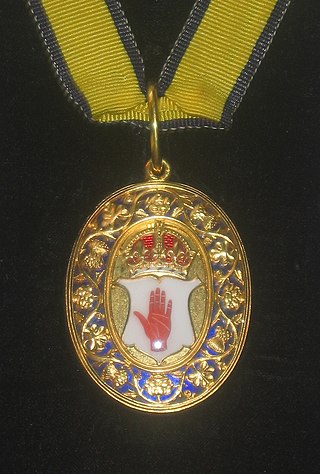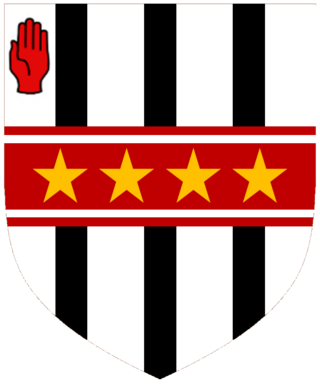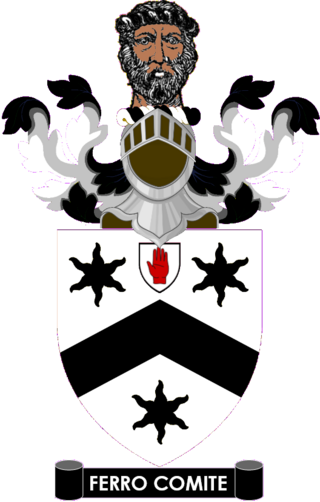Related Research Articles

Earl of Warwick is one of the most prestigious titles in the peerages of the United Kingdom. The title has been created four times in English history, and the name refers to Warwick Castle and the town of Warwick.

Earl of Iddesleigh, in the County of Devon, is a title in the Peerage of the United Kingdom. It was created in 1885 for the Conservative politician Sir Stafford Northcote, 8th Baronet, of Pynes in the parish of Upton Pyne near Exeter in Devon and lord of the manor of Iddesleigh, 28 miles north-west of Pynes. He served as President of the Board of Trade, Secretary of State for India, Chancellor of the Exchequer, First Lord of the Treasury and Foreign Secretary and was Joint Leader of the Conservative Party from 1881 to 1885. Northcote was made Viscount St Cyres, of Newton Saint Cyres in the County of Devon, at the same time he was given the earldom. This title is also in the Peerage of the United Kingdom.

Baron Leigh has been created twice as a hereditary title, once in the Peerage of England and once in the Peerage of the United Kingdom. The first creation came in the Peerage of England 1643 when Sir Thomas Leigh, 2nd Baronet, was created Baron Leigh, of Stoneleigh in the County of Warwick. The Leigh Baronetcy, of Stoneleigh in the County of Warwick, had been created in 1611 for his grandfather and namesake Thomas Leigh. The latter was the second son of Sir Thomas Leigh, Lord Mayor of London in 1558, whose third son Sir William Leigh was the grandfather of Francis Leigh, 1st Earl of Chichester. The titles became extinct on the death of the fifth Baron Leigh in 1786.

Baron Poltimore, of Poltimore in the County of Devon, is a title in the Peerage of the United Kingdom. It was created in 1831 for Sir George Bampfylde, 6th Baronet. His son, the second Baron, held office as Treasurer of the Household from 1872 to 1874 in the first Liberal administration of William Ewart Gladstone.

The Biddulph Baronetcy, of Westcombe in the County of Kent, is a title in the Baronetage of England. It was created on 2 November 1664 for Theophilus Biddulph, of Westcombe Park, Greenwich, Kent, Member of Parliament for the City of London and Lichfield. His son, Michael, the second Baronet, also represented Lichfield in the House of Commons. This line of the family failed on the death of the second Baronet's son, Theophilus, the third Baronet, in 1743. The late Baronet was succeeded by his first cousin once removed and namesake, Theophilus, the fourth Baronet. He was the son of Edward Biddulph, elder son of Simon Biddulph, younger son of the first Baronet. His grandson, Theophilus, the sixth Baronet, fought in the Battle of Waterloo and served as High Sheriff of Warwickshire in 1849. He was succeeded by his son, Theophilus, the seventh Baronet. He was a Deputy Lieutenant and Justice of the Peace for Warwickshire. On the death of his son, Theophilus, the eighth Baronet, in 1948, the line of Edward, elder son of Simon Biddulph, younger son of the first Baronet, failed. The late Baronet was succeeded by his fourth cousin once removed, Francis, the ninth Baronet. He was the great-great-grandson of Walter Biddulph, younger son of Simon Biddulph. As of 2008 the title is held by his grandson, Jack, the eleventh Baronet, who succeeded his father in 1986. The three most recent baronets have resided in Australia.

There have been four baronetcies created for persons with the surname Sykes, two in the Baronetage of Great Britain and two in the Baronetage of the United Kingdom. Three of the creations are extant as of 2008.
There have been seven baronetcies created for persons with the surname Thompson, one in the Baronetage of England, one in the Baronetage of Great Britain and five in the Baronetage of the United Kingdom. Three of the creations are extinct while four are extant. See also Thomson baronets and Meysey-Thompson baronets.
There have been two baronetcies created for persons with the surname Dugdale, both in the Baronetage of the United Kingdom.

The Cory-Wright Baronetcy, of Caen Wood Towers, High Gate, in St. Pancras in the County of London and Hornsey in the County of Middlesex, is a title in the Baronetage of the United Kingdom. It was created on 28 August 1903 for Cory Cory-Wright, Chairman of William Cory & Son, coal and oil shippers. Born Cory Wright, he assumed by Royal licence the additional surname of Cory in 1903. He was High Sheriff of Middlesex in 1902. The second Baronet was High Sheriff of Hertfordshire in 1921. The third Baronet was the husband of Felicity Tree, daughter of Sir Herbert Beerbohm Tree.

There have been eight baronetcies created for persons with the surname Wilson, one in the Baronetage of Ireland and six in the Baronetage of the United Kingdom.

There have been six baronetcies created with the surname of Leigh: two in the Baronetage of England, one in the Baronetage of Ireland, one in the Baronetage of Great Britain and two in the Baronetage of the United Kingdom. The only creation remaining extant is that of Altrincham, while another is dormant.
There have been three baronetcies created for persons with the surname Denny, one in the Baronetage of England, one in the Baronetage of Ireland and one in the Baronetage of the United Kingdom. As of 2014 two of the creations are extant.
There have been four baronetcies created for persons with the surname Temple, two in the Baronetage of England, one in the Baronetage of Nova Scotia and one in the Baronetage of the United Kingdom.

The Jaffray Baronetcy, of Skilts in the Parish of Studley in the County of Warwick, is a title in the Baronetage of the United Kingdom. It was created on 8 October 1892 for the journalist and newspaper proprietor John Jaffray. He was the co-founder of the Birmingham Post and Birmingham Mail.

The Keane Baronetcy, of Belmont in the County of Waterford, is a title in the Baronetage of the United Kingdom. It was created on 1 August 1801 for John Keane, Member of Parliament for Youghal from 1801 to 1806 and from 1808 to 1818. He had earlier represented Bangor in the Irish House of Commons. The second Baronet was Whig Member of Parliament for County Waterford between 1832 and 1835. The third Baronet served as high sheriff of County Waterford in 1856 and the fourth Baronet in 1881. The fifth Baronet was a Senator of the Irish Free State and Governor of the Bank of Ireland. The sixth Baronet, Sir Richard Keane, excelled in the military and also worked in 1930s as a diplomatic correspondent for The Times newspaper. Sir Richard Keane was also partly responsible for bringing the Military and Hospitaller Order of St. Lazarus of Jerusalem to Ireland in 1962 and was a Knight of St. Lazarus. As of 2014 the title is held by his son, the seventh Baronet, who succeeded in 2010.

There have been two baronetcies created for different branches of the Throckmorton family, 6th cousins, both descended from Sir John Throckmorton, Under-Treasurer of England temp. King Henry VI (1422–1461). Both titles, which were in the Baronetage of England, are now extinct. The Throckmortons, originally of Throckmorton near Pershore, Worcestershire, trace their history back to the 12th century. In 1409 Sir John de Throckmorton, Under-Treasurer of England, married Eleanor Spinney, daughter and heiress of Guy Spinney of Coughton, Warwickshire, where the senior branch of the family, which bore the junior baronetcy, became established. The Coughton estate included in 1968 a dower house named "Spiney House, Coughton", named after that family. The senior Throckmorton Baronetcy, of Tortworth in the County of Gloucester, was created in the Baronetage of England on 29 June 1611 for William Throckmorton, of Coss Court, Tortworth, Gloucestershire, sixth in descent from John Throckmorton, younger son of Sir John Throckmorton, Under-Treasurer of England. The third Baronet sat as Member of Parliament for Gloucestershire and Wotton Basset. The title became extinct on the death of the fourth Baronet in a duel in 1682.

The Chetwynd Baronetcy, of Brocton Hall in the County of Stafford, is a title in the Baronetage of Great Britain. It was created on 1 May 1795 for Sir George Chetwynd, Kt., of Brocton Hall, Staffordshire, for many years Clerk to the Privy Council. The second Baronet was member of parliament for Stafford and High Sheriff of Warwickshire in 1828. The fourth Baronet served as High Sheriff of Warwickshire in 1875. As of 13 June 2007 the presumed ninth Baronet has not successfully proven his succession and is therefore not on the Official Roll of the Baronetage, with the baronetcy dormant since 2004.
There have been three baronetcies created in the Baronetage of England for members of the Skipwith family of Skipwith, Yorkshire, which relocated to Lincolnshire in the 14th century. They were a successful court family, with one member, Margaret Skipwith, seen as a possible queen of England after the death of Henry VIII's third wife, Jane Seymour. One creation of the baronetcy is extant as of 2008.

The Mordaunt Baronetcy, of Massingham Parva in the County of Norfolk, is a title in the Baronetage of England. It was created on 29 June 1611 for Lestrange Mordaunt, who had earlier distinguished himself in the Wars of the Low Countries during the reign of Elizabeth I. The fifth, sixth, seventh and eighth Baronets all represented Warwickshire in the House of Commons. The ninth and tenth Baronets sat as Members of Parliament for Warwickshire South.
Sir Michael Henry Lakin, 1st Baronet, JP, DL, was a Warwickshire cement manufacturer who was created a Baronet in 1909.
References
- Kidd, Charles, Williamson, David (editors). Debrett's Peerage and Baronetage (1990 edition). New York: St Martin's Press, 1990, [ page needed ]
- Leigh Rayment's list of baronets